
How can early childhood educators implement continuous quality improvement with the Early Years Learning Framework?
The journey of evolving practice and making meaningful improvements never ends when it comes to enriching early learning and development outcomes for children.
That’s why the updated Early Years Learning Framework (EYLF) Version 2.0 offers such a valuable opportunity for services to lift quality to the next level - even though self assessment and the need for continual improvement goals to be created can feel overwhelming at times.
So the good news is this doesn’t need to be yet another ‘thing’ that becomes a source of overwhelm for already stretched educators and educational leaders juggling multiple roles while trying to also support other educators within their service..
While you or your team are probably already demonstrating many of the EYLF principles in action, the framework asks us to consistently self assess and plan for improvements to our practice - what can we do differently, do better or do more of?
The revisions to the EYLF framework highlight emerging focus areas like sustainability, cultural perspectives and reflective practice ready for further strengthening.
But with so much change on the horizon, where do you even begin so you don’t feel overwhelmed and instead approach EYLF v2.0 with confidence?
By taking small, practical steps forward, your early childhood service can make positive improvements over time in a sustainable way that energizes and motivates educators rather than deflating and frustrating them.
Let's start with the basics...an ongoing but simple Self Assessment process
How Educators Can Approach Thoughtful Self-Assessment?

Start by carefully looking at where your programs and environments are at now compared to the EYLF principles. Think about what's going well and where there's room to grow.
Then set some focused quality goals that will help make meaningful change happen gradually.
Break the goals down into smaller action steps that are doable. Track your progress.
With this flexible yet intentional approach, you can slowly transform your everyday practices, resources and teaching approaches to achieve the EYLF goals.
The change doesn't have to happen overnight - this isn't meant to be a 'tick the box and done' type task. Just focus on making steady improvements over months and years through continual review, planning and effort.

jodie clarke - the empowered educator
The key is viewing EYLF v2.0 as an ongoing guide for continuous improvement. Focus on progress, not instant perfection.
Try to celebrate established practices while developing areas of promise. With concerted effort, the updated framework should help you to evolve meaningful practice and expand outcomes.
So let’s break this down and explore the step-by-step process for planning and implementing continuous quality improvement aligned to EYLF v2.0...
How Educators Can Set Quality Improvement Goals...

The self-assessment should give you insights into strengths and areas for improvement. The next step is to turn those into clear quality goals (not ones that look good on your paperwork but are unrealistic for you to achieve!)
Come together as a team to analyse the assessment findings. What themes emerged around gaps to EYLF principles? Try not to feel discouraged if things aren't appearing the way you want them to - we all have room to grow no matter our level of experience - that's the point of this as an ongoing process.
Brainstorm goals that would lead to meaningful improvements in the priority areas identified. For example, building educator capabilities in cultural perspectives or sustainability.
The goals should focus on evolving practice, interactions and skills - not just purchasing new toys or resources. Sustainable change comes through us, the educators, first and foremost!
Emphasise goals around key focus areas in EYLF v2.0 like:
Draft 3-5 goals to start with. They should be clear, focused and achievable.
Now review if the goals seem realistic based on your specific context.
Consider your community, families, team experience and resources. We're aiming for progress, not instant perfection remember.
Some goals may need reframing if too ambitious. Break bigger goals into smaller steps for success.
Prioritise goals addressing EYLF v2.0 focus areas in need of development. But balance short term goals achievable within the year along with longer term goals requiring 2-3 years of concerted effort.
Schedule regular reviews of progress on longer-term goals to keep momentum going.
The final goals should pass the achievable test:
This goal setting process aims to build confidence that enhancing and improving quality outcomes is achievable over time and incremental progress on meaningful goals can be very motivating for adults.
Reflection Prompts To Ask yourself:
- How strongly do our programs match EYLF principles in action?
- Could our environments better demonstrate priorities like inclusion?
- Are new focus areas like reflective practice integrated?
- What feedback have families shared with us about our service?
This reflective step draws out the priority goals for your unique early education service type to focus quality efforts on next.
So don't rush it! Once you know where you are now through self-assessment, you can chart a simpler pathway forward by setting clear goals.

Documenting A Detailed Quality Improvement Plan
Once you've set some meaningful and realistic goals, it’s crucial to document the improvement plan to track implementation and progress. This involves outlining details, assigning tasks, scheduling reviews and sharing the plan.
Let's break that down by taking a look at an example case study. Imagine 'Creekside Early Learning Centre' conducted a self-assessment against EYLF v2.0. This highlighted two priority goals for them:
1. Improve cultural competence and integration of Aboriginal perspectives
2. Enhance sustainability initiatives across the service
Here is how they might document the plan:
Outline Details:
Draft a basic table to outline the following for each of your goals:
Objective: Short description of goal aim
Key Actions: Bullet list of specific tasks required
Responsibilities: Who will drive each action
Timeframe: Deadline for completionHere is an example of what Creekside’s simple draft plan might look like:
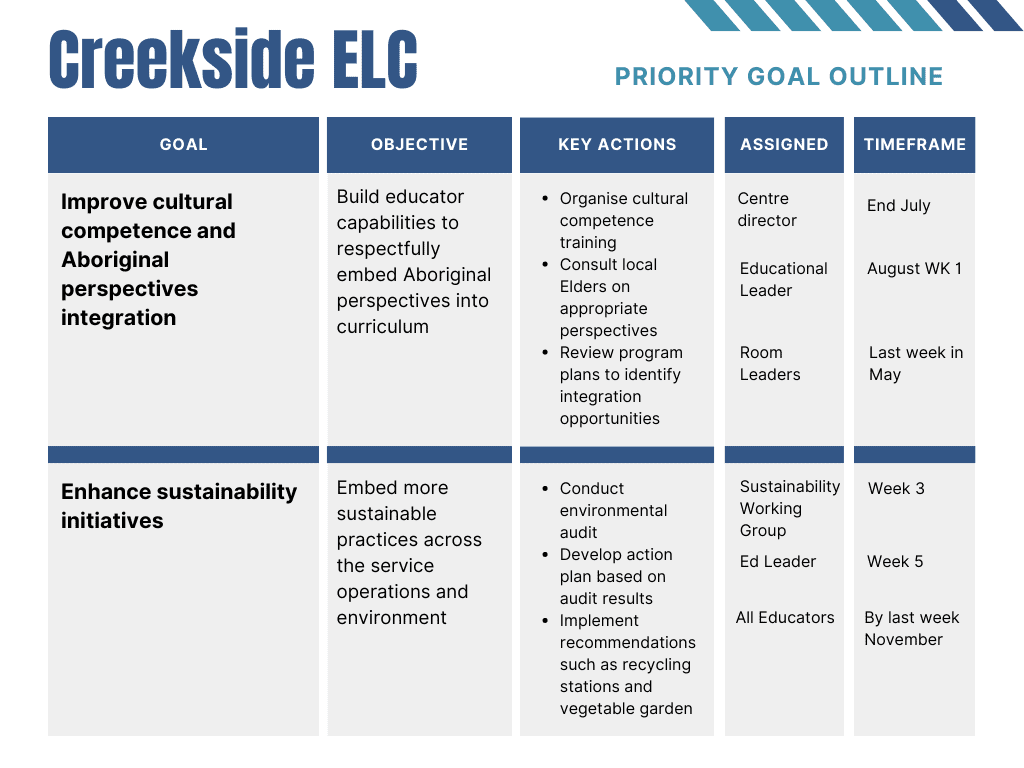
For a different perspective, take a look at this example for another imaginary early learning service called Sunshine Early Learners:
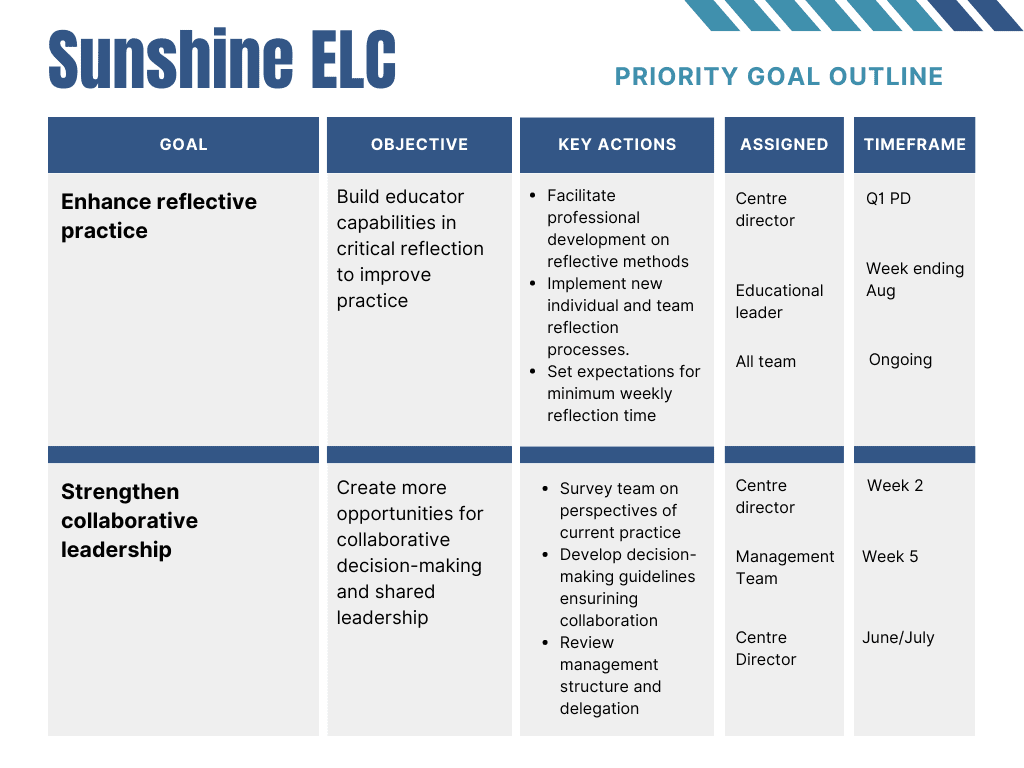
When we look at the key actions, the first focus is on building skills - giving educators more tools and knowledge around reflective practice through professional development.
Once capabilities are stronger, the next step is taking that learning and putting it into practice by actively changing processes as a team to embed more regular reflection and collaborative decision-making into everyday operations.
The plan gives everyone on the team clarity about who will be driving each action step and by when so they can maintain momentum. It's so important to have that level of detail mapped out upfront.
Then they can track how it's all going according to the plan during regular leadership meetings. This is where the progress reviews will be so valuable to identify what's working smoothly and where the service may need to adjust course along the way.
With this step-by-step process, the service can gradually turn the improvement goals from words on paper into practical changes and positive outcomes. But it takes commitment over time and ongoing communication!
Need a little more inspiration for how to do this for your service?
Let's look at an example for another fictional service called Little Green Rascals…
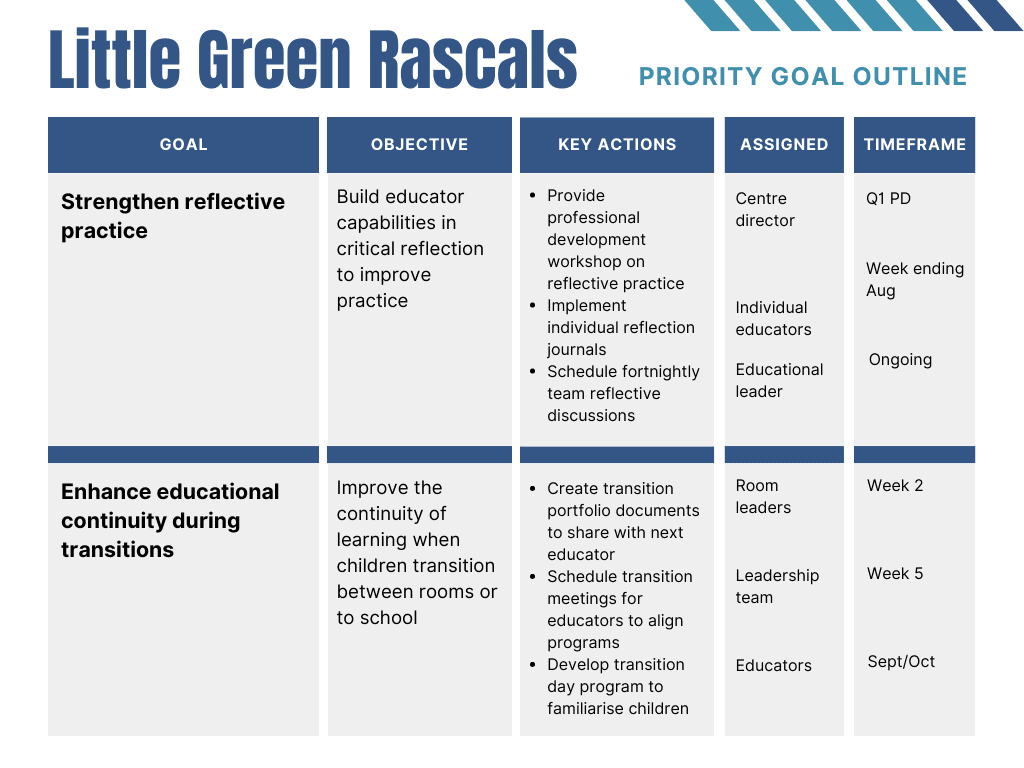
Their self-assessment highlighted two priority goals:
1.
Strengthening reflective practice skills. The key actions here focus on building capabilities through professional development, then embedding individual journals and regular team discussions into everyday operations.
2.
Enhancing educational continuity when children transition between age groups or to school. The steps involve creating portfolios to share with the next teacher, aligning programs via meetings, and familiarisation days for the children.
For each goal, responsibilities are outlined across roles along with timeframes for completion. So there is clarity on who needs to do what by when.
Tracking Progress Through Accountability Reviews

Tracking progress against timeframes and key actions helps maintain momentum and making sure you celebrate successes and achievements while addressing delays or obstacles leads to clear evidence of ongoing quality improvement.
Here’s an example of how an early childhood education service could conduct progress reviews for their quality improvement plan:
Little Smarties Early Learning Example
Progress Review: Enhance sustainability initiatives
Objective: Embed more sustainable practices across operations and learning environments
Key Achievements
- 3 out 4 actions completed on time!
- Energy audit completed in Week 3 (complete)
- Sustainability plan drafted in Week 5 (complete)
- Veggie garden installed in Term 2 Week 2 (complete)
Delays
Solar panels installation delayed due to contractor availability - rescheduled to Term 3 Week 2 (in progress)
Outcomes
- Significantly improved recycling practices and waste reduction
- Children enthusiastically engaging with new garden plots
Next Steps
- Celebrate successes like the garden installation
- Keep monitoring contractor to ensure revised solar panel timeline is met
- Plan next goal once solar panels are operational - e.g. water tank
Next Review: Term 2 Week 8
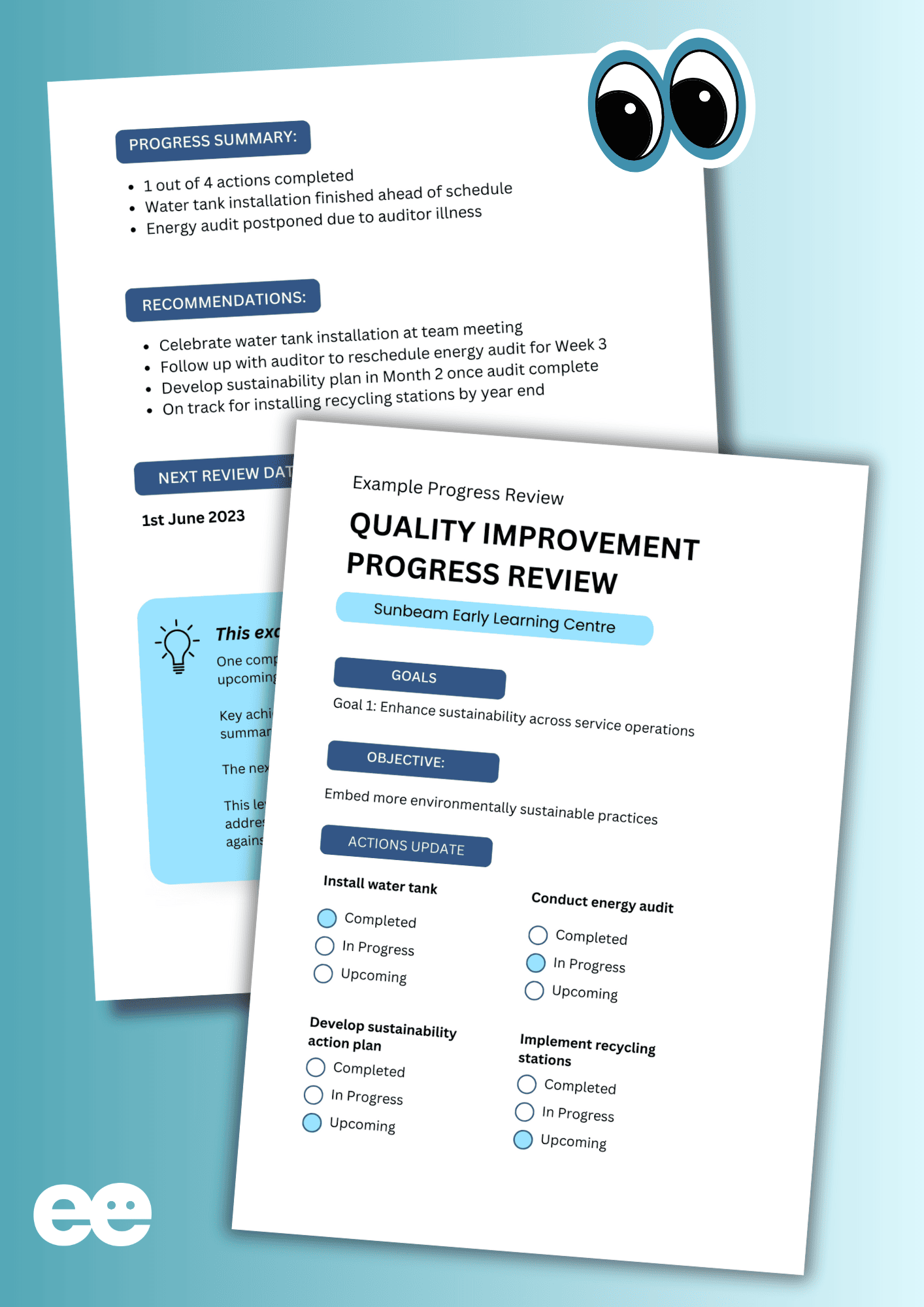
Progress reviews similar to this simple style can provide crucial accountability and help a service to collect important evidence that informs their future actions and consistently builds on their progress.
I've included this example in a FREE 'Quality Improvement Progress Review' template and guide - you can download it now by simply clicking below and letting me know where to send your copy...
Bringing the Plan to Life Through Collaboration
Once the documented improvement plan is finalised, the focus shifts to bringing it to life.
Here are some tips for making that happen:
Take Incremental Steps
As they say, Rome wasn't built in a day, and meaningful change takes time. Remain patient and focused on incremental progress.
Some improvements may be quick wins that embed rapidly like introducing reflection journals. Others like building cultural competence require years of sustained effort to truly integrate.
View the path as cyclic - each step builds capabilities that enable larger gains over time. Maintain realistic expectations around timeframes.
For bigger goals, try and break them down first into smaller incremental objectives. Ticking off mini-milestones provides motivation for everyone rather than just feeling like “it’s all too hard to achieve so why even bother” mentality.
Provide Professional Development
Invest in developing the knowledge, skills and attitudes of educators related to goals. This transforms plans into practice.
Professional development comes in many forms - here's some ideas for you...
Formal training courses and workshops
Conferences to gain new perspectives
Team membership to professional development hubs like The Academy Of Empowered Educators
Peer observation and mentoring programs
Internal communities of practice
Recommended reading lists and resources
This enables new approaches to be adopted smoothly.
Work Collaboratively
Rather than leaders dictating what must change, empower all educators to actively contribute to the improvement process.
Collaboration and teamwork lead to expertise sharing and better outcomes.
Promote collaborative:
- Decision making
- Problem solving
- Knowledge sharing
- Reflective practice
This drives improvement further than individual efforts.
Addressing Resistance Openly and Constructively
We all know that change can be uncomfortable. Some team members may be resistant or unsure how to implement new practices. So what then?
Instead of ignoring the proverbial elephant in the home corner - acknowledge openly that initial discomfort is temporary and common in growth and they are not the only ones who might be thinking this way.
Provide supportive mentoring as needed when you can until integration of this new process becomes more natural.
Celebrate Achievements
With a well-documented plan, commitment and care for your team, the change process WILL lead to positive outcomes over time.
As educators tick off completed actions, achieve success with new approaches or reach goal milestones - celebrate these wins!
Celebration maintains motivation and positivity to keep momentum going. Improvement is uplifting, not discouraging.
Here are some practical tips to help you address resistance to change:
Listen empathetically to understand the roots of hesitation or skepticism. Don't dismiss concerns.
Communicate frequently on why the change is happening and the benefits for children, families and educators.
Involve resisters in the change process through input or working groups so they feel ownership.
Provide supportive coaching and mentoring to build capabilities and confidence with new approaches.
Share examples and stories demonstrating positive impacts of the change on practice.
If resistance persists, discuss one-on-one how to address concerns constructively.
Start small with incremental changes so people aren't overwhelmed. Build on successes.
Celebrate small wins and milestones to maintain morale. Change is uplifting, not discouraging.
Seek feedback regularly. Continual improvement means being responsive.
Allow time for new practices to integrate before expecting expertise. Rome wasn't built in a day.
Encourage peer support between eager and reluctant educators to promote benefits.
With empathy, communication and inclusion, resistance can transform into openness over time.
Here are some tips for encouraging peer support between eager and reluctant educators when implementing changes:

Buddy up eager and reluctant educators for collaborative activities like planning, reflection or team teaching new approaches. This peer modelling can inspire.

Have eager educators share their success stories or benefits observed informally. Make sure this is done constructively, not critically.

Set up opportunities for reluctant educators to shadow more confident peers trying new approaches to build skills through observation.

Establish small communities of practice groups with a mix of abilities to problem solve together. Diversity brings fresh perspectives.

Promote a strengths-based culture where skills like creativity or organisation are valued alongside openness to trying new things.

Schedule collaborative time for educators to support each other in a non-judgemental way with implementation concerns or ideas.

Encourage sharing of resources and tips between peers rather than top down from leaders. Peer exchange can be more relatable.

Provide recognition when reluctant educators make incremental progress. Have eager peers acknowledge their efforts.

Remind all educators continually that a diversity of strengths allows the team to flourish.
With support and incentives for collaboration, peer dynamics can positively influence growth mindsets.
Key Tips for Successful Implementation
Take incremental steps forward. Don't expect instant perfection. Celebrate mini-milestones.
Provide professional development to build capabilities related to goals. This brings plans to life.
Promote a collaborative culture. Empower all educators to contribute ideas and track progress.
Acknowledge challenges openly but stay positive. Support educators through any discomfort.
Celebrate small achievements to maintain motivation. Improvement uplifts!
Document the plan for clarity on who does what by when. Display it prominently so everyone stays on track.
Schedule regular progress reviews to identify what’s working smoothly and where to fine tune.
Involve families through surveys and focus groups for insights to guide your path.
By taking small, consistent steps with intention and care for your team, you will see the positive impact and be able to track continuous improvement.
The continuous quality improvement journey with EYLF v2.0 should be a positive one, not an overwhelming one - I hope you’ve seen throughout the tips and strategies I’ve shared in this article that it's actually about progress over perfection.
When educators are encouraged to take a step-by-step approach involving thoughtful self-assessment, collaborative goal setting and accountable action, meaningful change is absolutely achievable for every unique early learning setting.
The focus should be on celebrating small wins and sustainable development over time. This is a marathon, not a sprint Empowered ed’s!
Quality improvement never ends – there are always opportunities for new growth.
Be proud of the quality practices you’ve already embedded, while maintaining a mindset open to thoughtfully evolving based on self-review insights. Make sure to involve your whole team through open communication and engagement at each phase. Foster a culture where everyone feels empowered to contribute ideas, track progress, and identify areas needing more TLC.
With a sustained effort over the long-term, the process of assess, plan and act will allow you to successfully integrate the new inclusions in the EYLF v2.0.

You’ll continuously strengthen quality across all aspects of your practice, policies, environments and culture and ultimately, this leads to high quality early childhood experiences where children are happy, engaged early learners, families feel involved and informed, and educators feel valued, skilled and purposeful.
The journey does require commitment and effort of course, but the outcomes and progress for children, families and early education professionals like you make it so worthwhile.
Start where you are, use resources like the progress review template I’ve provided you with to plan and show evidence of your work, and know that taking small steps to support incremental change builds to larger transformative results.
Wishing you all the best on your quality journey ahead!
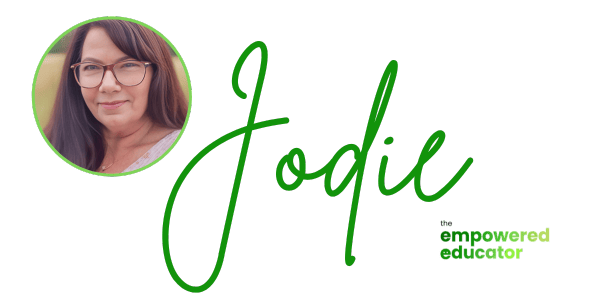
Watch on demand workshops, download templates and follow step by step action guides to make the process of quality improvement planning as you incorporate the EYLF v2.0 changes easier and faster with access to everything you need at your fingertips inside the Academy for Empowered Educators.
The 4 Pillar Keep It Simple Approach To Planning is incorporated into all of the resources, training and templates throughout The Academy For Empowered Educators to ensure early childhood educators can spend more time engaging & extending learning with the children and less time documenting.

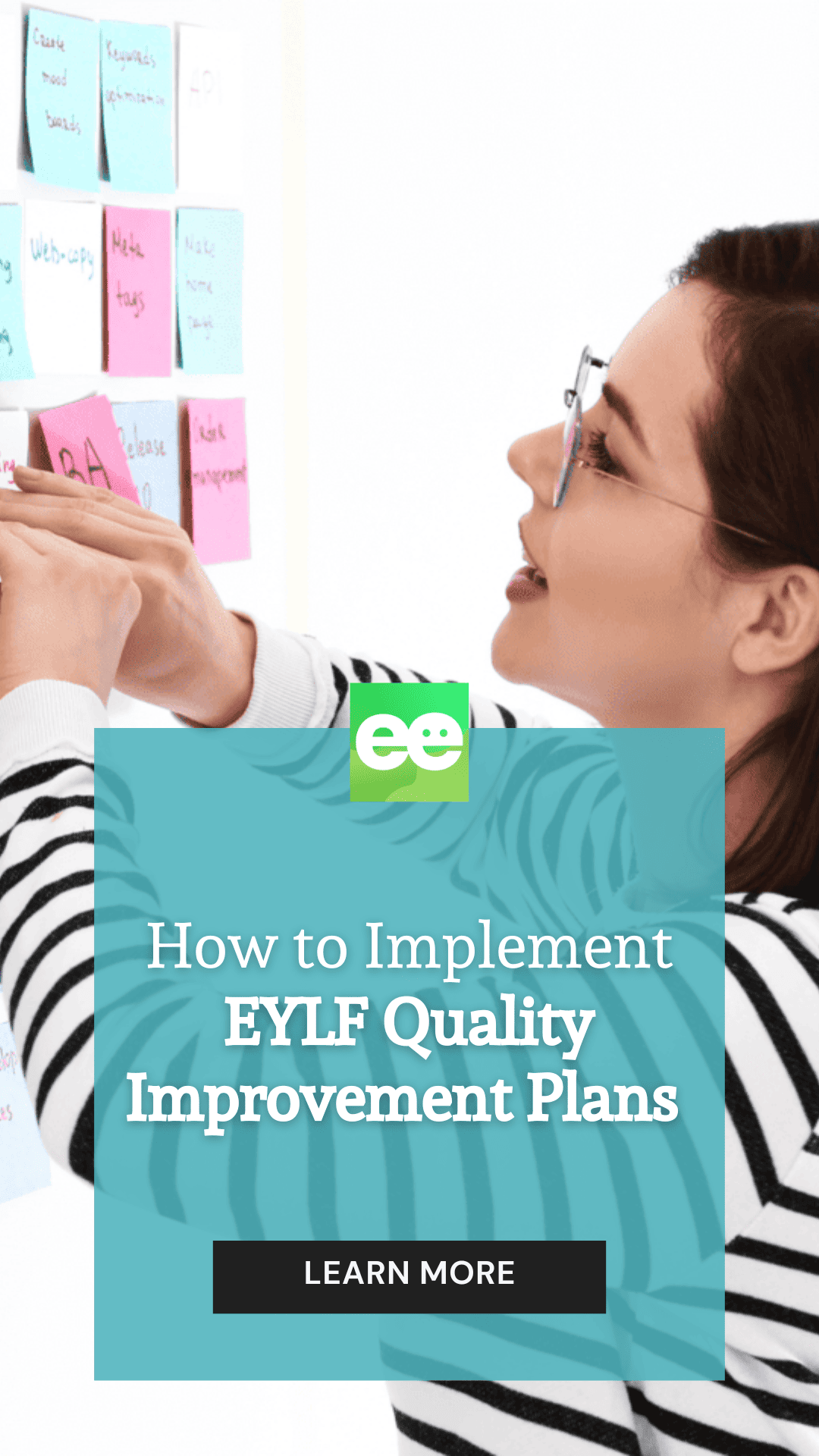
A Little About Me
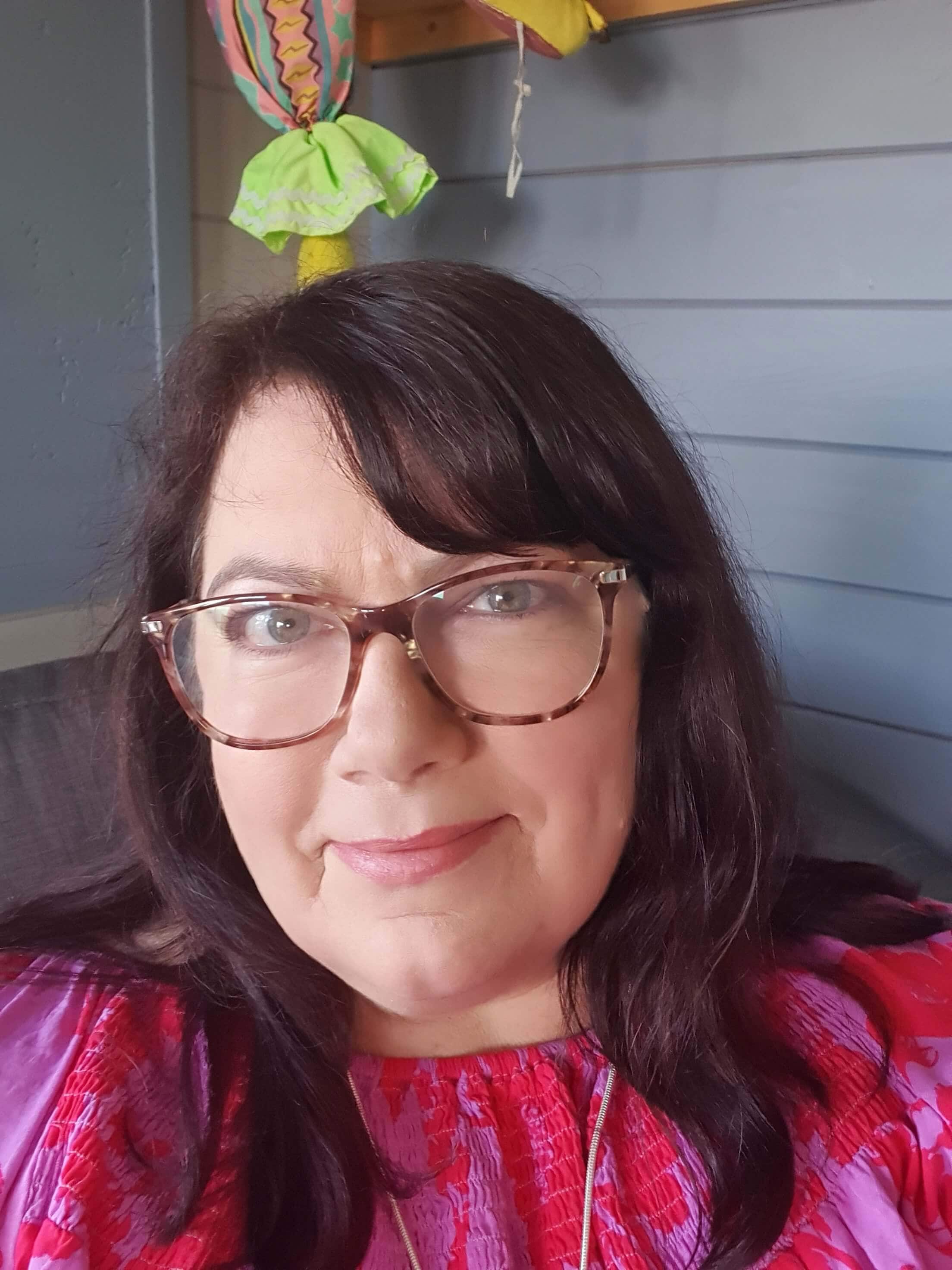
Jodie Clarke is an early childhood professional supporting educators who want and need to stay passionate about the work they do! She has 30 years hands-on experience in the early childhood and human services sectors across many different roles.
Jodie is mum to 3 in Australia and has already helped thousands of educators with their work through her popular blog posts, activity ideas, online training and e-books.
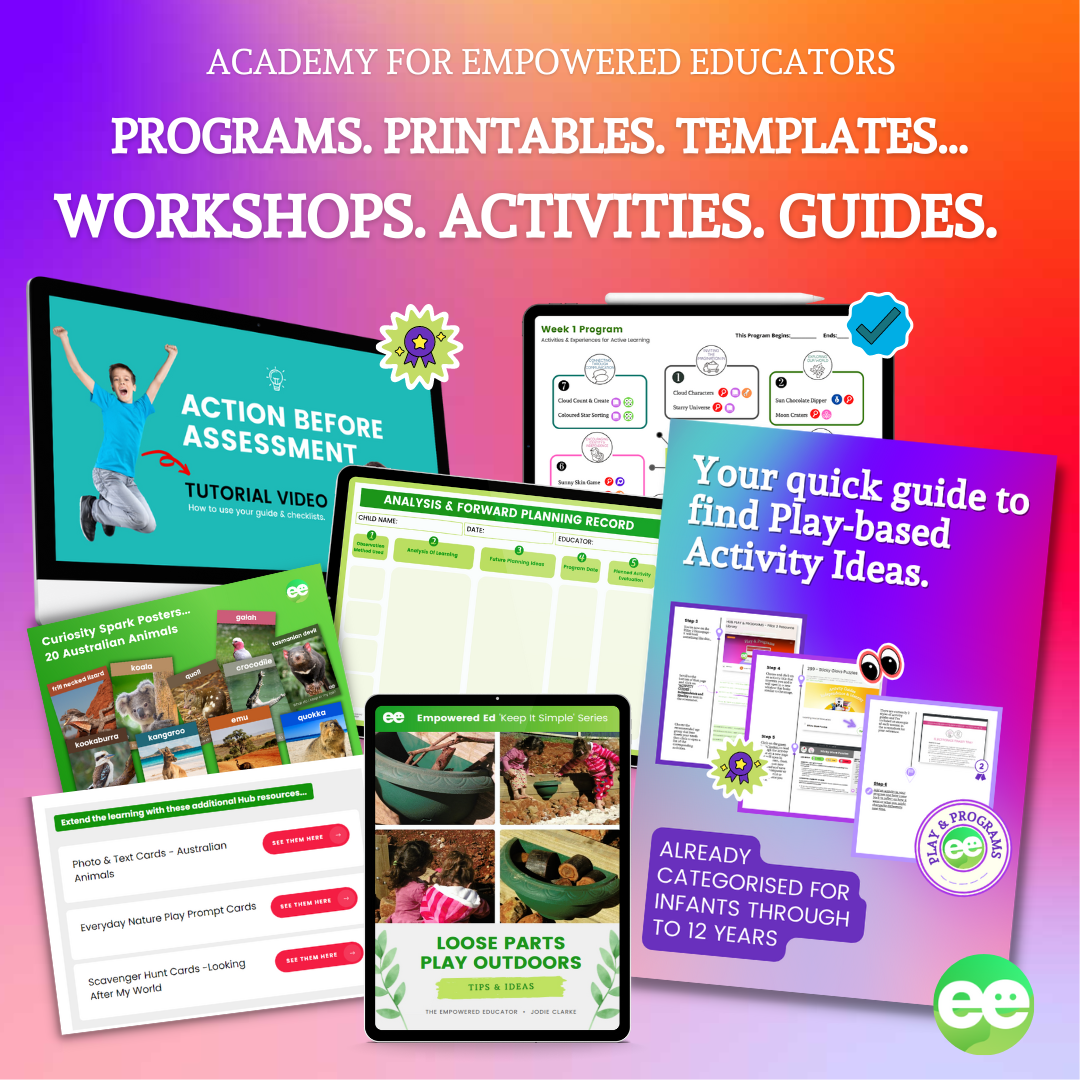
Leave a Reply